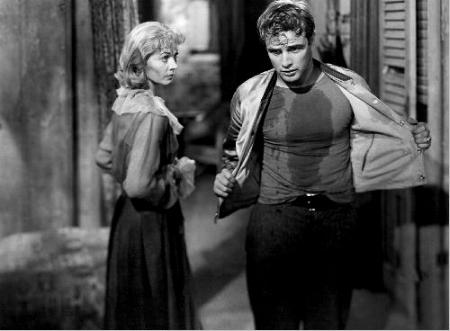Audition, Assemble, Act!
 In this unit, entitled “Audition, Assemble, Act,” we will read Tennessee Williams’ classic drama A Streetcar Named Desire. This six-week unit will get students moving and acting. The unit will center on different style pedagogies; students will cycle each week in our reading of the play by doing some early-week scene reading, mid-week persuasive writing, and late-week staging and performing of a scene or scene segment. This gets us more involved with close reading in addition to thinking about using textual evidence to support roles and claims.
In this unit, entitled “Audition, Assemble, Act,” we will read Tennessee Williams’ classic drama A Streetcar Named Desire. This six-week unit will get students moving and acting. The unit will center on different style pedagogies; students will cycle each week in our reading of the play by doing some early-week scene reading, mid-week persuasive writing, and late-week staging and performing of a scene or scene segment. This gets us more involved with close reading in addition to thinking about using textual evidence to support roles and claims.
Mondays and Tuesdays throughout the unit will be used to read two or three scenes from Streetcar. Wednesdays will be used to write persuasively to audition for one of many roles for the late-week performance (roles include: actor, understudy, director, assistant director, backstage director, music master, videographer, costume designer, props designer, set designer, and critic). Thursdays allows us to cast the roles based on the persuasive writing as well as preview the next scene. Fridays will be used to perform the scene, including blocking and rehearsing time. It is my primary goal that this will aid to foster a community of learners, actors, and writers. I will draw on students in Claremont’s Theatre II class to help be leaders.
Students, meanwhile, will be responsible for keeping a character journal to talk about key questions, respond to ideas about the text, and keep track of important details. This will be assessed each week for a reading comprehension (quiz) grade.
Text Set
A Streetcar Named Desire (Tennessee Williams)
A Streetcar Named Desire (film adaptations)
Philosophical articles (excerpts) on lying, moral responsibility, hedonism; including Aristotle’s Poetics
Reviews of play
Big Ideas and Essential Questions
- How does what we say differ from what we do, and vice versa? What does it mean to show versus to tell?
- What motivates people to lie? Is lying ever acceptable? How do we judge people who lie?
- Why do people seek friendship, companionship, or romance? What does this have to do with happiness?
- What does it mean to be happy?
These questions allow us to talk about characterization, both in reading and in staging the play. Different characters have differing motivations, which evolve and devolve. Students will have to grapple with their own actions and how what they say versus what they do is perceived differently.
Learning Goals
For key learning goals, see the corresponding Growth & Learning sub-section.
Curriculum Standards
RL.1 | “Cite strong and thorough textual evidence to support analysis of what the text says explicitly as well as inferences drawn from the text, including determining where the text leaves matters uncertain.” We will examine writing in the “reader” context and the “actor” context while examining key moments in the text, such as looking at the writing to figure out how best to perform it.
RL.2 | “Determine two or more themes or central ideas of a text and analyze their development over the course of the text, including how they interact and build on one another to produce a complex account; provide an objective summary of the text.” We will explore our essential questions as well as use time in class to engage with class conversations.
RL.3 | “Analyze the impact of the author’s choices regarding how to develop and relate elements of a story or drama (e.g., where a story is set, how the action is ordered, how the characters are introduced and developed).” We will pay particular attention, and talk about, the mysterious nature of Blanche’s past. We will write about the rapid character development and how characters change or stay the same.
RL.5 | “Analyze how an author’s choices concerning how to structure specific parts of a text (e.g., the choice of where to begin or end a story, the choice to provide a comedic or tragic resolution) contribute to its overall structure and meaning as well as its aesthetic impact.” By staging and performing key moments in the play, we will see how meaning can change.
RL.7 | “Analyze multiple interpretations of a story, drama, or poem (e.g., recorded or live production of a play or recorded novel or poetry), evaluating how each version interprets the source text.” Part of our time will be spent watching clips and scenes from adaptations of the play and analyzing their differences from the text. We will pay particular attention to the Marlon Brando classic version.
RL.9 | “Demonstrate knowledge of eighteenth-, nineteenth- and early-twentieth-century foundational works of American literature, including how two or more texts from the same period treat similar themes or topics.” This seminal work of American drama provides a backdrop for talking about themes in American literature, and we will weave this discussion into talking about other texts with which students are familiar, including their work with To Kill a Mockingbird last year.
RI.4 | “Determine the meaning of words and phrases as they are used in a text, including figurative, connotative, and technical meanings; analyze how an author uses and refines the meaning of a key term or terms over the course of a text.” In our text set, our tackling of philosophical texts (mostly excerpts) will introduce many new terms typically unrelated to the study of literature.
RI.5 | “Analyze and evaluate the effectiveness of the structure an author uses in his or her exposition or argument, including whether the structure makes points clear, convincing, and engaging.” The philosophical text set will require analysis as to whether the arguments made a convincing case.
W.2.a-f | “Write informative/explanatory texts to examine and convey complex ideas, concepts, and information clearly and accurately through the effective selection, organization, and analysis of content. (a) Introduce a topic; organize complex ideas, concepts, and information so that each new element builds on that which precedes it to create a unified whole; include formatting (e.g., headings), graphics (e.g., figures, tables), and multimedia when useful to aiding comprehension. (b) Develop the topic thoroughly by selecting the most significant and relevant facts, extended definitions, concrete details, quotations, or other information and examples appropriate to the audience’s knowledge of the topic. (c) Use appropriate and varied transitions and syntax to link the major sections of the text, create cohesion, and clarify the relationships among complex ideas and concepts. (d) Use precise language, domain-specific vocabulary, and techniques such as metaphor, simile, and analogy to manage the complexity of the topic. (e) Establish and maintain a formal style and objective tone while attending to the norms and conventions of the discipline in which they are writing. (f) Provide a concluding statement or section that follows from and supports the information or explanation presented (e.g., articulating implications or the significance of the topic).” As part of ongoing assessment beyond the acting, students will responsible for a variety of writing assignments, including a variety of short writing assignments (one of which is the persuasive writing component) to be cast in roles as well as end of the unit writing meant to review Streetcar.
W.10 | “Write routinely over extended time frames (time for research, reflection, and revision) and shorter time frames (a single sitting or a day or two) for a range of tasks, purposes, and audiences.” Daily journal writing will attempt to get students thinking about character development and motivations.
SL.1.a-d | “Initiate and participate effectively in a range of collaborative discussions (one-on-one, in groups, and teacher-led) with diverse partners on grades 11–12 topics, texts, and issues, building on others’ ideas and expressing their own clearly and persuasively. (a) Come to discussions prepared, having read and researched material under study; explicitly draw on that preparation by referring to evidence from texts and other research on the topic or issue to stimulate a thoughtful, well-reasoned exchange of ideas. (b) Work with peers to promote civil, democratic discussions and decision-making, set clear goals and deadlines, and establish individual roles as needed. (c) Propel conversations by posing and responding to questions that probe reasoning and evidence; ensure a hearing for a full range of positions on a topic or issue; clarify, verify, or challenge ideas and conclusions; and promote divergent and creative perspectives. (d) Respond thoughtfully to diverse perspectives; synthesize comments, claims, and evidence made on all sides of an issue; resolve contradictions when possible; and determine what additional information or research is required to deepen the investigation or complete the task.” Beyond in-class discussions, the work with creating scenes will involve discussion and debate over roles, how to create and convey characters, and how to stage scenes.
SL.6 | “Adapt speech to a variety of contexts and tasks, demonstrating a command of formal English when indicated or appropriate.” Acting will require many different contexts of speaking, and students will have to adapt week-to-week to new roles.
L.6 | “Acquire and use accurately general academic and domain-specific words and phrases, sufficient for reading, writing, speaking, and listening at the college and career readiness level; demonstrate independence in gathering vocabulary knowledge when considering a word or phrase important to comprehension or expression.” We will use domain specific vocabulary—tier 3 theatre words—when working with scenes. Weekly vocabulary activities will supplement in-class reading.



